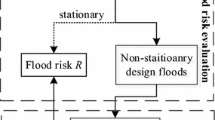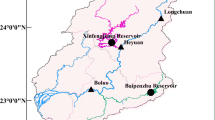Abstract
Several small reservoirs and a large number of check dams had been constructed in the Wangkuai reservoir watershed after 1970s, and flood time series lacked stationarity, which affected the original design flood hydrographs for the Wangkuai reservoir. Since the location, storage capacity and drainage area of the large number of check dams were unknown, we present a method to estimate their total storage capacities (TSC) and total drainage areas (TDA) by using the recorded rainstorm and flood data. On the basis of TSC and TDA, the flood events which occurred in an undisturbed period were reconstructed under current conditions to obtain a stationary flood series. A frequency analysis was subsequently performed to assess the design flood peak and volume for both small and medium design floods with a 10–200 year return period. For large and catastrophic floods, it was assumed that the upstream check dams and small reservoirs would be destroyed, and water stored in these hydraulic structures were re-routed to the Wangkuai reservoir by unit hydrograph. The modified flood peak and volume decreased for floods with a 10–200 year return period when compared to the current design flood. But for large design floods with a return period exceeding 500 years, peak discharge increased. This study provides a new method for design flood calculation or modification of the original design flood in watersheds with a large number of check dams.






Similar content being viewed by others
References
Archer D and Newson M 2002 The use of indices of flow variability in assessing the hydrological and instream habitat impacts of upland afforestation and drainage; J. Hydrol. 268 244–258.
Ayalew T B, Krajewski W F and Mantilla R 2014 Connecting the Power-law scaling structure of peak-discharges to spatially variable rainfall and catchment physical properties; Adv. Water Resour. 71 32–43.
Carrivick J L 2007 Hydrodynamics and geomorphic work of Jokulhlaups (glacial outburst floods) from Kverkfjoll volcano, Iceland; Hydrol. Process. 21 725–740.
Carrivick J L 2010 Dam break-outburst flood propagation and transient hydraulics: A geoscience perspective; J. Hydrol. 380 338–355.
Cunderlik J M and Burn D H 2003 Non-stationary pooled flood frequency analysis; J. Hydrol. 276 210–223.
Costa M H, Botta A and Cardille J A 2003 Effects of large-scale changes in land cover on the discharge of the Tocantins River, southeastern Amazonia; J. Hydrol. 283 206–217.
Cox D R, Isham V S and Northrop P J 2002 Floods: Some probabilistic and statistical approaches; Phil. Trans. Roy. Soc. London, Ser. A 360 1389–1408.
Feng P and Li X 2013 Bivariate frequency analysis of non-stationary flood time series based on Copula methods; J. Hydraul. Eng. 44 1137–1147.
Feng P, Zeng H and Li X 2013 Non-stationary flood frequency analysis based on mixed distribution; J. Tianjin University 46 298–303.
Fitzhugh T W and Vogel R M 2010 The impact of dams on flood flows in the United States; River Res. Appl. 27 1192–1215.
Genz F and Luz L D 2014 Distinguishing the effects of climate on discharge in a tropical river highly impacted by large dams; Hydrol. Sci. J. 57 1020–1034.
Gilroy K L and McCuen R H 2012 A nonstationary flood frequency analysis method to adjust for future climate change and urbanization; J. Hydrol. 414 40–48.
Graf W L 2006 Downstream hydrologic and geomorphic effects of large dams on American rivers; Geomorphology 79 336–360.
Gupta V K, Troutman B M and Dawdy D R 2007 Towards a nonlinear geophysical theory of floods in river networks: An overview of 20 years of progress; Nonlinear Dyn. I Geosci., pp. 121–151.
Gupta V K, Mantilla R, Troutman B M et al. 2010 Generalizing a nonlinear geophysical flood theory to medium-sized river networks; Geophys. Res. Lett. 37 L11402, doi: 10.1029/2009GL041540.
Hsieh H M, Luo C R, Yang J C et al. 2013 Numerical study of the effects of check dams on erosion and sedimentation in the Pachang river; Int. J. Sedim. Res. 28 304–315.
Katz R W, Partang M B and Naveau P 2002 Statistics of extremes in hydrology; Adv. Water Resour. 25 1287–1304.
Khaliq M N, Ouarda T B M J, Ondo J C et al. 2006 Frequency analysis of a sequence of dependent and/or non-stationary hydro-meteorological observations: A review; J. Hydrol. 329 534–552.
Lajoie F, Assani A A, Roy A G et al. 2007 Impacts of dams on monthly flow characteristics, the influence of watershed size and seasons; J. Hydrol. 334 423– 439.
Li X 2013 Flood analysis and calculation based on non-stationary flood time series; Tianjin University, Tianjin.
Magilligan F J and Nislow K H 2005 Changes in hydrological regime by dams; Geomorphology 71 61–78.
Matteau M, Assani A A and Mesfioui M 2009 Application of multivariate statistical analysis methods to the dam hydrologic impact studies; J. Hydrol. 371 120–128.
Milly P C D, Betancourt J, Falkenmark M et al. 2008 Stationarity is dead: Whither water management?; Science 319 573–574.
Niehoff D, Fritsch U and Bronstert A 2002 Land-use impacts on storm-runoff generation: Scenarios of land use change and simulation of hydrological response in a meso-scale catchment in SW-Germany; J. Hydrol. 267 80–93.
Nirupama N and Simonovic S P 2007 Increase of flood risk due to urbanisation: A Canadian example; Natural Hazards 40 25–41.
Ogden F L and Dawdy D R 2003 Peak discharge scaling in small Hortonian watershed; J. Hydrol. Eng. 8 64–73.
Onema J K, Mazvimavi D, Love D et al. 2006 Effects of selected dams on river flows of Insiza river, Zimbabwe; Physics and Chemistry of the Earth 31 870–875.
Ott B and Uhlenbrook S 2004 Quantifying the impact of land-use changes at the event and seasonal time scale using a process-oriented catchment model; Hydrol. Earth Syst. Sci. 8 62–78.
Richter B D, Baumgartner J V, Wigington R et al. 1997 How much water does a river need?; Freshwater Biology 37 231–249.
Robinson J S, Sivapalan M and Snell J D 1995 On the relative roles of hillslope processes, channel routing, and network geomorphology in the hydrologic response of natural catchments; Water Resour. Res. 31 3089–3101.
Robinson M, Cognard-Plancq A L, Cosandey C et al. 2003 Studies of the impact of forests on peak flows and baseflows: A European perspective; Forest Ecol. Manag. 186 85–97.
Saghafian B 2006 Nonlinear transformation of unit hydrograph; J. Hydrol. 330 596–603.
Smith S V, Renwick W H, Bartley J D et al. 2002 Distribution and significance of small, artificial water bodies across the United States landscape; Sci. Total Environ. 299 21–36.
Strupczewski W G, Singh V P and Feluch W 2001a Non-stationary approach to at-site flood frequency modeling I. Maximum likelihood estimation; J. Hydrol. 248 123–142.
Strupczewski W G, Singh V P and Mitosek H T 2001b Non-stationary approach to at-site flood frequency modeling III. Flood analysis of Polish rivers; J. Hydrol. 248 152–167.
Tarolli P, Borga M, Morin E et al. 2012 Analysis of flash flood regimes in the north-western and south-eastern Mediterranean regions; Natural Hazards and Earth Syst. Sci. 12 1255–1265.
The Ministry of Water Resources of the People’s Republic of China 1994. Standard for flood control (GB50201-94).
Walder J S and Costa J E 1996 Outburst floods from glacier-dammed lakes: The effect of mode of lake drainage on flood magnitude; Earth Surface Processes and Landforms 21 701–723.
Wang J C, Yu H and Zhao J 2000 Relation of design flood peak discharge rate to collecting area in Nenjiang river basin; J. Heilongjiang Hydraulic Engineering College 27 15–16.
Wellmeyer J L, Slattery M C and Phillips J D 2005 Quantifying downstream impacts of impoundment on flow regime and channel planform, lower Trinity river, Texas; Geomorphology 69 1–13.
Yu K and Moyeed R A 2001 Bayesian quantile regression; Statistics and Probability Letters 54 437–447.
Yu K, Lu Z and Stander J 2003 Quantile regression: Applications and current research area; The Statistician 52 331–350.
Zahar Y, Ghorbel A and Albergel J 2008 Impacts of large dams on downstream flow conditions of rivers: Aggradation and reduction of the Medjerda channel capacity downstream of the Sidi Salem dam (Tunisia); J. Hydrol. 351 318–330.
Zhang J Z and Mao H H 2012 Study on methods for modification of design flood under condition of change in underlying surface; Water Resour. Hydropower Eng. 43 1–5.
Zimmerman J K H, Letcher B H, Nislow K H et al. 2010 Determining the effects of dams on subdaily variation in river flows at a whole-basin scale; River Res. Appl. 26 1246–1260.
Acknowledgements
This work was supported by National Natural Science Foundation of China (No. 51209157). We are grateful to Arun Ravindranath of the CUNY (City University of New York) City College for his valuable advice on the study. We also express our thanks to Hydrology and Water Resource Survey Bureau of Hebei Province for providing the hydrometeorological data.
Author information
Authors and Affiliations
Corresponding author
Additional information
Corresponding editor: Shivam Tripathi
Rights and permissions
About this article
Cite this article
Li, J., Sun, H. & Feng, P. How to update design floods after the construction of small reservoirs and check dams: A case study from the Daqinghe river basin, China. J Earth Syst Sci 125, 795–808 (2016). https://doi.org/10.1007/s12040-016-0688-8
Received:
Revised:
Accepted:
Published:
Issue Date:
DOI: https://doi.org/10.1007/s12040-016-0688-8




